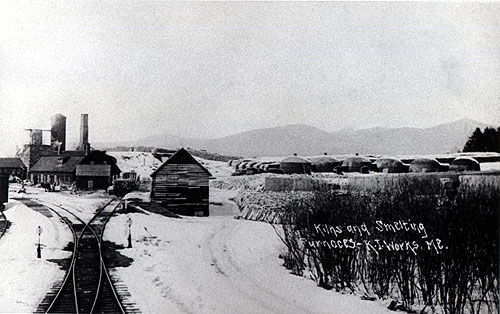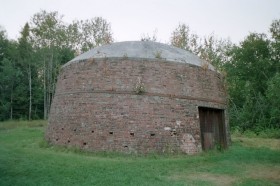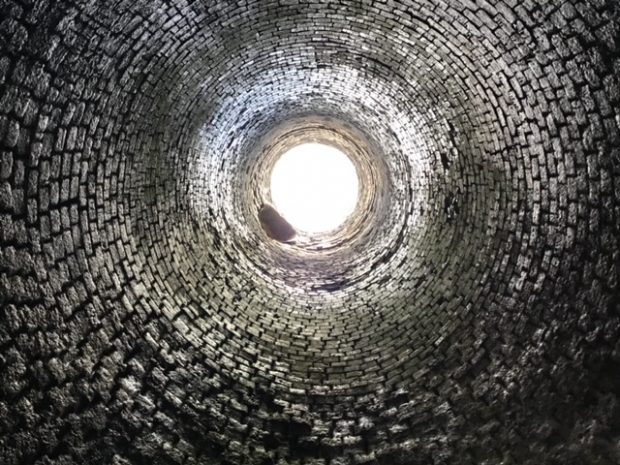 Katahdin Iron Works Blast Furnace (2002)
Katahdin Iron Works Blast Furnace (2002)
National Register of Historic Places – Listings
Katahdin Iron Works
[Northwest of Brownville Junction at Silver Lake] Katahdin Iron Works Township, T6 R9 NWP, is an unorganized township northwest of Brownville and just east of Gulf Hagas and The Hermitage.
Red iron oxide from Ore Mountain is believed to have been the source of paint for the “red paint people” who inhabited the area 2000 years ago.
Kilns and Smelting Furnaces at Katahdin Iron Works
According to the Maine Bureau of Parks and Recreation, whose photo appears above,
Between 1843 and 1890, these structures pulsed with activity as part of Maine’s only nineteenth century iron works operation. The fires of the blast furnace flamed non-stop, glowing against the night sky. Such sights and sounds must have seemed out of place in the Maine wilderness. Yet, it was the wilderness, with its ready supplies of iron ore, fuel wood, and waterpower that brought the iron works industry to this site.
White settlers first entered this area in 1815. Mining and smelting operations started in 1843 and continued until 1856. The original blast furnace, rebuilt in 1874, was improved in 1877 but burned in 1883.
The present structure is the remains of the new blast furnace built in 1885. At the height of operations, about 200 men were employed in mining, wood cutting and smelting before production ceased in 1890.
Originally part of a larger parcel, the land containing the blast furnace and remaining charcoal kiln was donated to the Maine Bureau of Parks and Recreation, which has operated it as an historic site since 1965.
Pig iron ingots were first hauled to Bangor by horse or oxen. Returning wagons brought lime from Rockland. After 1869, shipments were made by rail from Dover and Milo. The railroad reached the Iron Works in 1882 and operated until 1922.
The charcoal kiln (also called a beehive oven) was built in about 1880. It is the only remaining example of sixteen similar buildings at the Iron Works.
Interior
The kiln is approximately thirty feet in diameter and eighteen feet high. To make charcoal, the kiln was loaded from the top with fifty cords of wood. The wood was then burned by a charring fire, which was controlled by opening and closing small openings at the base of the kiln. The “charring” fire produced charcoal rather than ash.
After the charcoal was removed, it was transported to the blast furnace where it was used in the iron smelting process. Each furnace charge required all the charcoal produced in the kiln. As a result, many kilns were needed to keep the furnace in steady operation.
Preservation of the blast furnace has been supported by the Allied Chemical and Dye Company of New York.
Sources: Maine Bureau of Parks and Recreation, information posted at the historic site. Black and white photo is from the Bureau’s Internet site.
Additional resources
Ballard, David. Kiln interior photo.
Eastman, Joel W. A History of the Katahdin Iron works. Orono, Me., University of Maine, 1965. Thesis (M. A.) in History and Government-University of Maine, Orono, 1965.
Katahdin Iron Works. Records, 1846-1975. (bulk 1846-1970) [University of Maine, Raymond H. Fogler Library, Special Collections]
“Katahdin Iron Works”, Katahdin, Me.: recently purchased of the executors of the estate of the late David Pingree, Salem, Mass. : reports of Charles T. Jackson … [et al.] Issued by Edward G. Tileston & Co. Boston. T.R. Holland. 1863. [Maine State Library]
Maine Department of Conservation. Maine Geological Survey. “The Iron Age of Maine – 1800’s – Katahdin Iron Works.” http://www.maine.gov/doc/nrimc/mgs/explore/mining/sites/sept03.htm (accessed December 31, 2011)
Maine Department of Conservation. “Find Parks & Lands.” http://www.maine.gov/cgi-bin/online/doc/parksearch/index.pl (accessed December 31, 2011)
Sawtell, William R. K. I. III. 1988. Bangor, Me. Furbush-Roberts Printing Co.
Sawtell, William R. Katahdin Iron Works: Boom to Bust. Milo, Me. Milo Printing Co. 1982.
Smith, David G. Papers, 1888-1990. (Cataloger Note: . . . information about the town of Brownville, Maine; the Katahdin Iron Works, an iron-producing company operating near Brownville Junction during the 19th century; and the Gulf Hagas region as well as materials about hunting, fishing and outdoor life in general.) Includes information about the Pine Knot family camp in the area.






